Just: bakterielle Toxine
Werbung
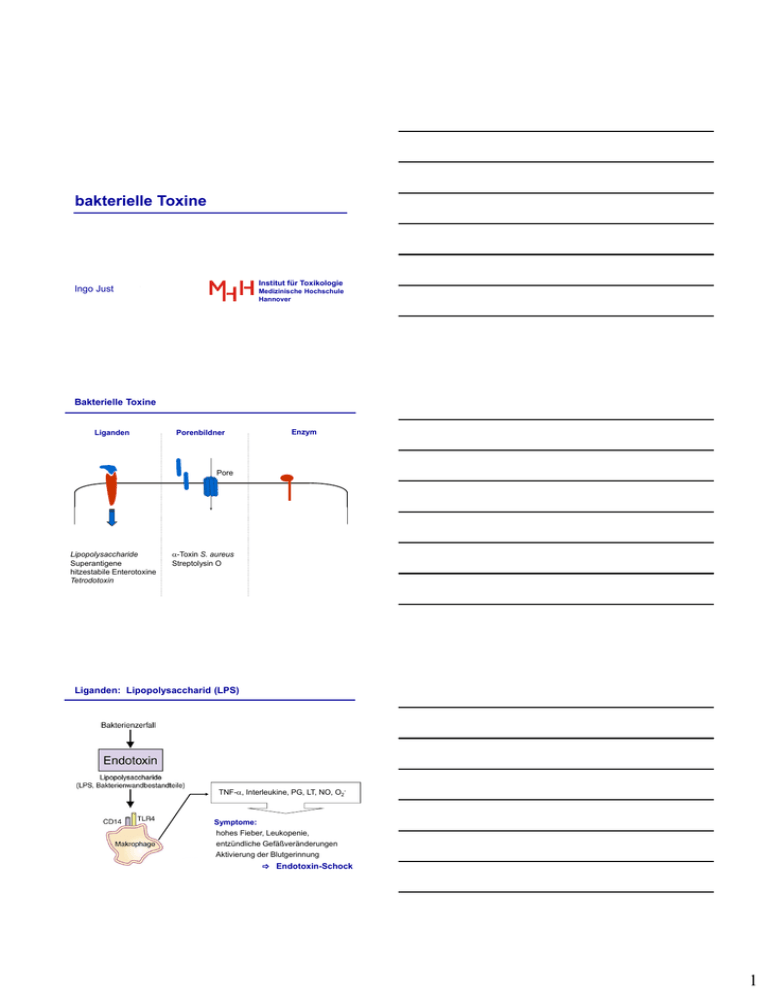
bakterielle Toxine Institut für Toxikologie Ingo Just Medizinische Hochschule Hannover Bakterielle Toxine Liganden Porenbildner Enzym Pore Lipopolysaccharide Superantigene hitzestabile Enterotoxine Tetrodotoxin -Toxin S. aureus Streptolysin O Liganden: Lipopolysaccharid (LPS) TNF-, Interleukine, PG, LT, NO, O2- Symptome: hohes Fieber, Leukopenie, entzündliche Gefäßveränderungen Aktivierung der Blutgerinnung Endotoxin-Schock 1 Liganden: Tetrodotoxin bakterielles Neurotoxin Blockade spannungsabh. Na+-Kanäle Vorkommen: Kugelfisch (Fugu) LD 1 mg Bakterielle Toxine Liganden Porenbildner Enzym Pore (Lipopolysaccharide) Superantigene hitzestabile Enterotoxine Tetrodotoxin -Toxin S. aureus Streptolysin O Endoproteasen ADP-Ribosyltransferasen N-Glycosidasen A - B Toxine Bakterielle Toxine: zelluläre Aufnahme Cholera Toxin Pertussis Toxin Shiga Toxin Anthrax Toxin Diphtherie Toxin Botulinum Toxine 2 Diphtherie-Toxin Diphtherie Corynebacterium diphtheriae Symptome: Pseudomembranen im Rachen Erstickungsgefahr Myocarditis Spättod durch Herzversagen Neuropathie Diagnose: Therapie: klin. Bild / bakteriologisch Diphtherie-Antitoxin, Penicillin S-S EnzymKomponente TransportKomponente Diphtherie-Toxin aa aa aa aa aa aa aa aa-tRNA aa aa ADP-Ribose aa aa OH aa OH aa EF-2 mRNA AUG CUG CUC AUG CUG CUC Ribosomen EF-2 Elongationsfaktor 2 Hemmung der Proteinbiosynthese Zelltod Therapeutischer Einsatz von Diphtherie-Toxin S-S EnzymKomponente TransportKomponente antineoplastische Therapie Apoptose von Krebszellen targeting: IL-2 Rezeptor Stopp der Proteinbiosynthese: ADP-Ribosylierung von EF-2 S-S Denileukin Diftitox Ontak® EnzymKomponente IL-2 3 Shiga-Toxin Shigella dysenteriae und E. coli (EHEC) N-Glycosidase S Adenin aus 28 rRNA Hemmung der Proteinbiosynthese S Bindung Globotriaosylceramid (Gb3) Golgi Apparat Diarrhö Hämolytisch-urämisches Syndrom Nierenversagen Thrombozytopenie Shiga-Toxin aa aa aa aa aa aa aa aa-tRNA aa aa ADP-Ribose aa aa OH aa OH aa EF-2 mRNA AUG CUG CUC AUG CUG CUC Ribosomen EF-2 Elongationsfaktor 2 Shiga-Toxin, Hemmung der Proteinbiosynthese Ricin N-Glykosidase Deadenylierung 28 rRNA Zelltod Cholera Toxin Cholera Vibrio cholerae Symptome: Brech-Durchfall Flüssigkeitsverlust Kollaps Diagnose: Therapie: bakteriologisch Rehydratation, Antibiose S_S Rezeptor Rezeptor G-Protein Gs G-Protein Gs G-Protein Gs G-Protein Gs ADP-Ribose c-AMP c-AMP Cl- Sekretion 4 Cl- H2O Na+ H2O Na+ ClCl- Cl- Cl- ClA H2O CFTR GM1 P P Cl - A1 cA Kinase ADP-Ribose ADP-Ribose Gs GTP cAMP ATP cAMP cAMP cAMP ATP Adenylyl Cyclase CFTR: cystic fibrosis conductance regulator Anthrax-Toxine Milzbrand (Anthrax) Symptome: Zoonose Bacillus anthracis Mensch Haut-, Lungen- Darmmilzbrand Diagnose: klin. Bild / bakteriologisch Therapie: Ciprofloxacin / Doxycyclin für 60 d Anthrax-Toxin Letaler Faktor Ödematisierender Faktor PA protektives Antigen Anthrax-Toxine letales Toxin: PA + LF LF MAPKK Macrophagen: Apoptose bei Zelllyse proimmatorische Zytokine ödematisierendes Toxin: PA + EF ATP Calmodulin Ca2+ EF cAMP Ödembildung Hemmung der Phagezytose 5 Clostridiale Neurotoxine Clostridium botulinum Neurotoxine A B C1 D E F G mit Hämagglutininen assoziiert 300-900 kDa C. tetanus Toxin C- Bindung und Aufnahme S Struktur S N- Zn-Protease Nicking Botulismus: schlaffe Lähmung Tetanus: spastische Lähmung Botulismus Ptosis Diplopie Dysarthrie Dysphagie keine Bewusstseinstrübung schnell fortschreitende, symmetrische, absteigende Lähmung Foodborn botulism The infant looks “floopy” Intoxikation Infektion Botulinum neurotoxin and Tetanus toxin, edited by L.L. Simpson, Academic Press 1989 Tetanus Therapie ? Sir Charles Bell, 1774-1814 Neugeborenentetanus 6 New Engl J Med 347:382 (2002) Rückenmark Clostridiale Neurotoxine-Wirkmechanismus + - inhibitorisches Interneuron proteolytische Spaltung von cholinerges Neuron TeNT proteolytische Spaltung von Synaptobrevin Hemmung der Glycin-, GABA-Freisetzung SNARE-Proteinen Hemmung der Acetylcholin- BoNT Freisetzung motorische Endplatte Therapeutischer Einsatz von Botulinum Neurotoxin A Ind. Therapie von Dystonien (Blepharospasmus) Spastizität (nach Apoplex, neurogene Inkontinenz) Strabismus live style drug: Antifaltenmittel Dosis U UAW: Lähmung benachbarter Muskelgruppen lokale Reiz- und Entzündungszeichen Antikörperbildung (= LD50 der Maus) bioterroristische Waffe? 7 Bakterielle Toxine therapeutischer Ansatz: Impfung Virulenzfaktor zellbiologisches Werkzeug Cholera Toxin / Pertussis Toxin heterotrimere G-Proteine Botulinum Toxin Exozytose-Vorgänge Streptolysin / -Toxin Porenbildner therapeutischer Einsatz Botulinum Toxin A: fokale Dystonien Immunotoxine (Diph-Tox + IL-2) bioterroristische Waffen Botulinum Neurotoxine Anthrax Toxine Akute Toxizität von Giftstoffen Substanz NaCl LD50 (µg/kg KG) 4.000.000 Coffein 250.000 HCN 1.000 Toxin Anthrax-Toxine Diphtherie-Toxin Botulinum Neurotoxine LD50 (µg/kg KG) 1 0,3 0,0003 8
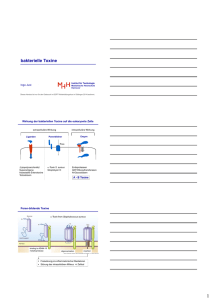
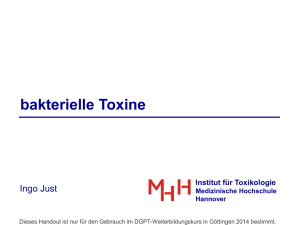
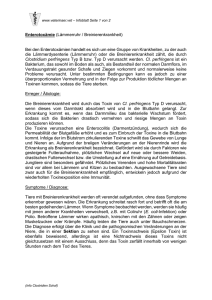
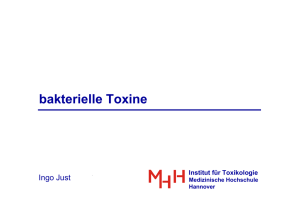
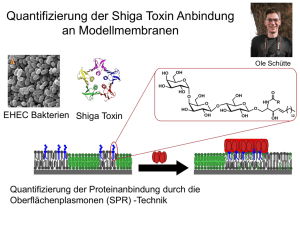
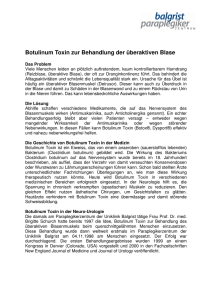
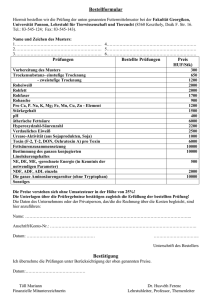
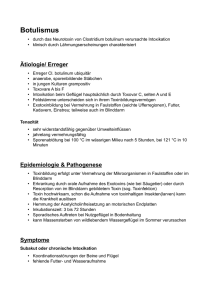
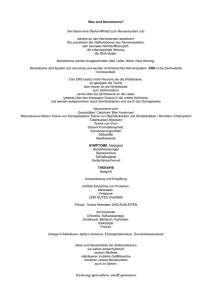
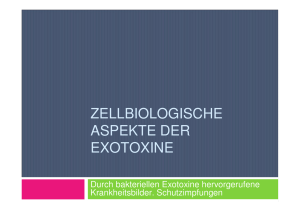
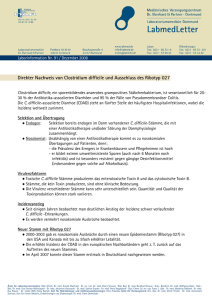
![06-Binder.ppt [Schreibgeschützt]](http://s1.studylibde.com/store/data/008940731_1-d50c0eda1f100ff48f36d1d5b534c415-300x300.png)